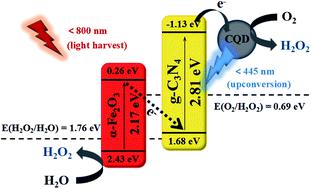当前位置:
X-MOL 学术
›
J. Mater. Chem. A
›
论文详情
Our official English website, www.x-mol.net, welcomes your feedback! (Note: you will need to create a separate account there.)
Sacrificial agent-free photocatalytic H2O2 evolution via two-electron oxygen reduction using a ternary α-Fe2O3/CQD@g-C3N4 photocatalyst with broad-spectrum response
Journal of Materials Chemistry A ( IF 11.9 ) Pub Date : 2020-08-08 , DOI: 10.1039/d0ta05753c Xi Chen 1, 2, 3, 4, 5 , Wenwen Zhang 4, 5, 6, 7, 8 , Lixiang Zhang 4, 5, 6, 7, 8 , Luping Feng 1, 2, 3, 4, 5 , Chunxian Zhang 4, 5, 6, 7, 8 , Jie Jiang 4, 9, 10, 11 , Tingjiang Yan 4, 5, 6, 7, 8 , Hua Wang 1, 2, 3, 4, 5
Journal of Materials Chemistry A ( IF 11.9 ) Pub Date : 2020-08-08 , DOI: 10.1039/d0ta05753c Xi Chen 1, 2, 3, 4, 5 , Wenwen Zhang 4, 5, 6, 7, 8 , Lixiang Zhang 4, 5, 6, 7, 8 , Luping Feng 1, 2, 3, 4, 5 , Chunxian Zhang 4, 5, 6, 7, 8 , Jie Jiang 4, 9, 10, 11 , Tingjiang Yan 4, 5, 6, 7, 8 , Hua Wang 1, 2, 3, 4, 5
Affiliation

|
Ultrathin g-C3N4 nanosheets have been fabricated via a two-step calcination regulated by melamine precursors at a high heating rate (30 °C min−1). The resulting g-C3N4 nanosheets were further employed as carriers for the growth of carbon quantum dots (CQDs) and (110) exposed α-Fe2O3 through the PVP-enabled adsorption effects by a solvothermal process. It was discovered that the so fabricated ternary photocatalyst α-Fe2O3/CQD@g-C3N4 presented a broad-spectrum absorption range (up to 800 nm) and particularly enhanced active sites of photogenerated electrons for highly efficient photocatalytic oxygen reduction toward H2O2 evolution in pure water. A H2O2 production rate of 1.16 μM min−1 could be expected for the developed photocatalyst under visible light irradiation, which is about 19 times faster than that of pure ultrathin g-C3N4. Herein, the loaded Fe2O3 could transform the H2O2 evolution from two-step single-electron reduction into one-step two-electron one, as verified by the various active species experiments and rotating ring-disk electrode tests. This work presents a new perspective in designing ultrathin g-C3N4 through a simple method of precursor-regulated calcination, which features more outstanding advantages than the conventional exfoliation of bulk g-C3N4 towards ultrathin g-C3N4. More importantly, it provides an optimized photocatalytic reaction route of two-electron oxygen reduction for efficient H2O2 production in pure water under visible light irradiation, without the need for noble metals or organic sacrificial agents.
中文翻译:

使用具有广谱响应的三元α-Fe2O3/ CQD @ g-C3N4光催化剂通过两电子氧还原反应生成无牺牲剂的光催化H2O2
已经通过三步煅烧由三聚氰胺前体调节的两步煅烧以高加热速率(30°C min -1)制备了超薄gC 3 N 4纳米片。将得到的GC 3 Ñ 4纳米片进一步用作载体为碳量子点(CQDs)和生长(110)暴露的α-Fe 2 ö 3通过溶剂热方法启用PVP-吸附效果。据发现,在这样制造的光催化剂的三元的α-Fe 2 ö 3 / CQD @ GC 3 Ñ 4他提出了一个广谱吸收范围(高达800 nm),特别是增强了光生电子的活性位,以实现高效的光催化氧还原,使其在纯水中向H 2 O 2析出。在可见光照射下,已开发的光催化剂的AH 2 O 2生产率有望达到1.16μMmin -1,比纯超薄gC 3 N 4快约19倍。在此,负载的Fe 2 O 3可以转化H 2 O 2从两步单电子还原到一步两电子还原的过程,已通过各种活性物种实验和旋转环盘电极测试得到验证。这项工作提出了一种通过前体调节煅烧的简单方法设计超薄gC 3 N 4的新视角,与传统的将大块gC 3 N 4剥落至超薄gC 3 N 4的常规方法相比,它具有更为突出的优势。更重要的是,它为高效H 2 O 2提供了优化的两电子氧还原的光催化反应路线 在可见光辐射下在纯水中生产,不需要贵金属或有机牺牲剂。
更新日期:2020-09-22
中文翻译:

使用具有广谱响应的三元α-Fe2O3/ CQD @ g-C3N4光催化剂通过两电子氧还原反应生成无牺牲剂的光催化H2O2
已经通过三步煅烧由三聚氰胺前体调节的两步煅烧以高加热速率(30°C min -1)制备了超薄gC 3 N 4纳米片。将得到的GC 3 Ñ 4纳米片进一步用作载体为碳量子点(CQDs)和生长(110)暴露的α-Fe 2 ö 3通过溶剂热方法启用PVP-吸附效果。据发现,在这样制造的光催化剂的三元的α-Fe 2 ö 3 / CQD @ GC 3 Ñ 4他提出了一个广谱吸收范围(高达800 nm),特别是增强了光生电子的活性位,以实现高效的光催化氧还原,使其在纯水中向H 2 O 2析出。在可见光照射下,已开发的光催化剂的AH 2 O 2生产率有望达到1.16μMmin -1,比纯超薄gC 3 N 4快约19倍。在此,负载的Fe 2 O 3可以转化H 2 O 2从两步单电子还原到一步两电子还原的过程,已通过各种活性物种实验和旋转环盘电极测试得到验证。这项工作提出了一种通过前体调节煅烧的简单方法设计超薄gC 3 N 4的新视角,与传统的将大块gC 3 N 4剥落至超薄gC 3 N 4的常规方法相比,它具有更为突出的优势。更重要的是,它为高效H 2 O 2提供了优化的两电子氧还原的光催化反应路线 在可见光辐射下在纯水中生产,不需要贵金属或有机牺牲剂。



























 京公网安备 11010802027423号
京公网安备 11010802027423号